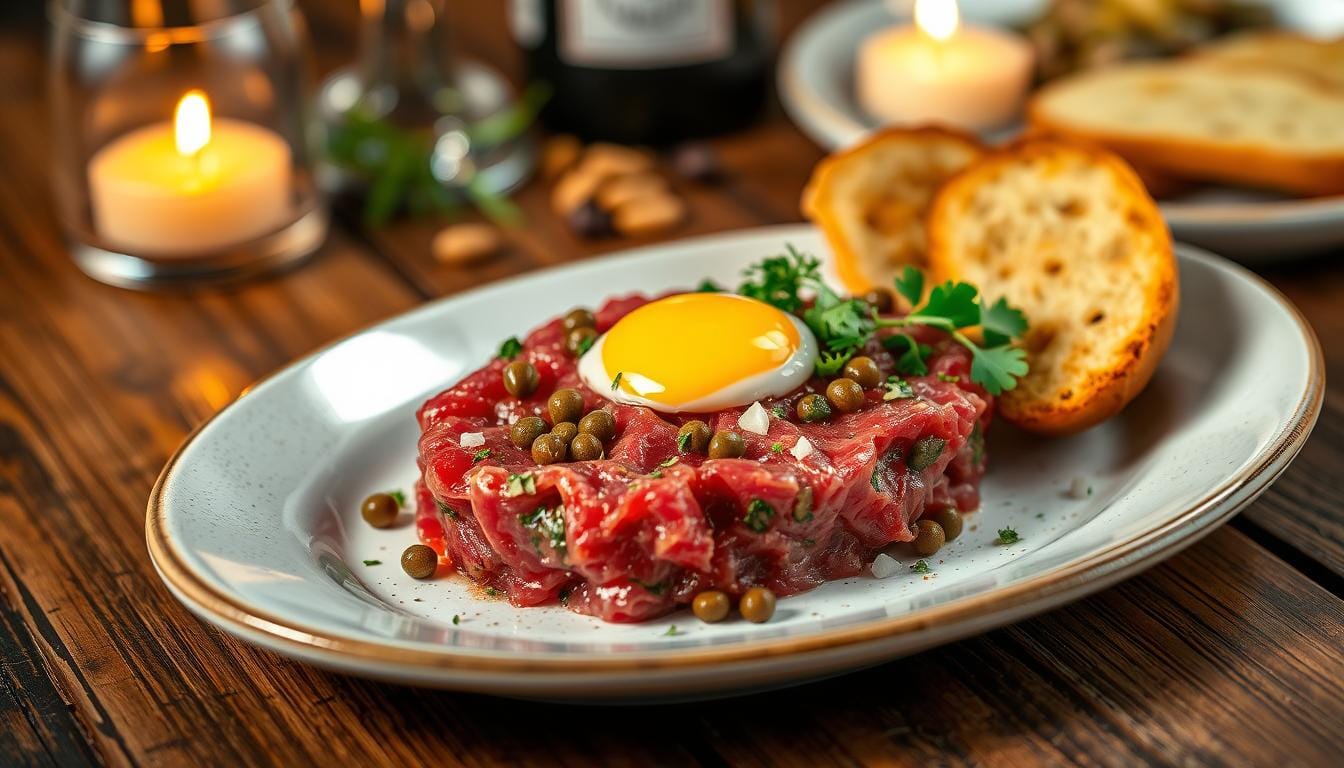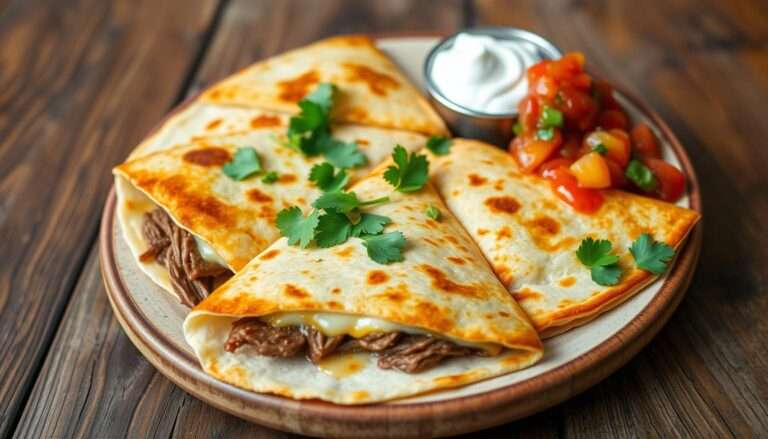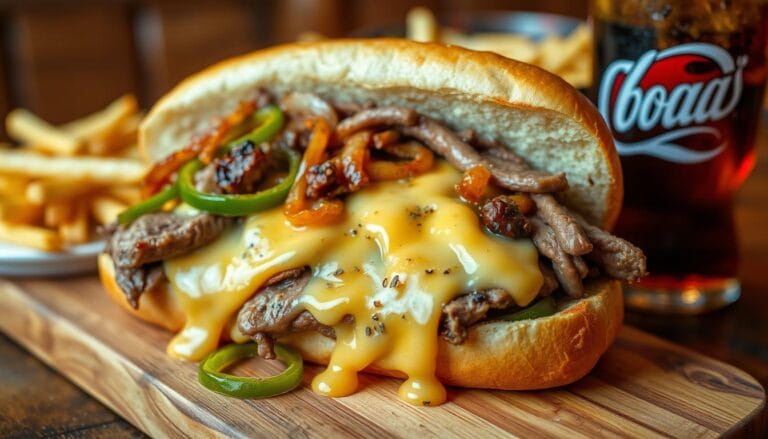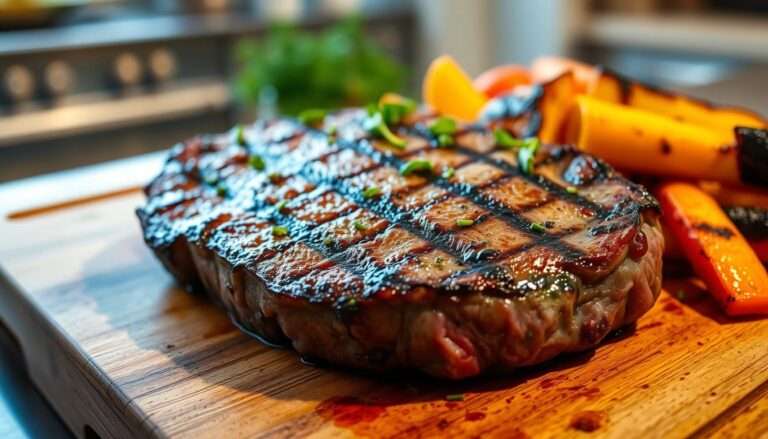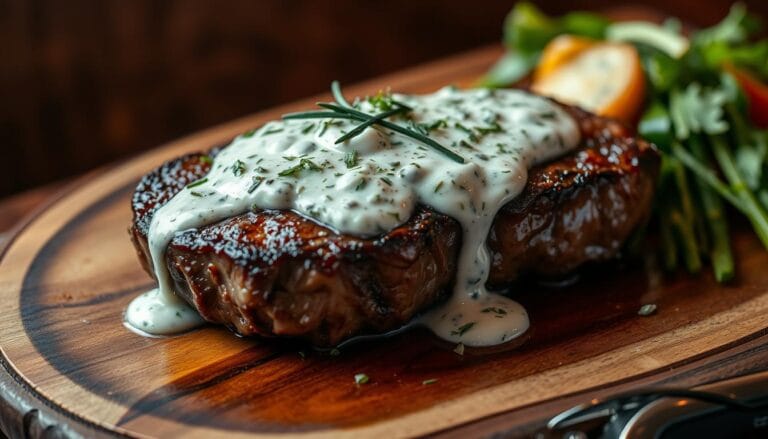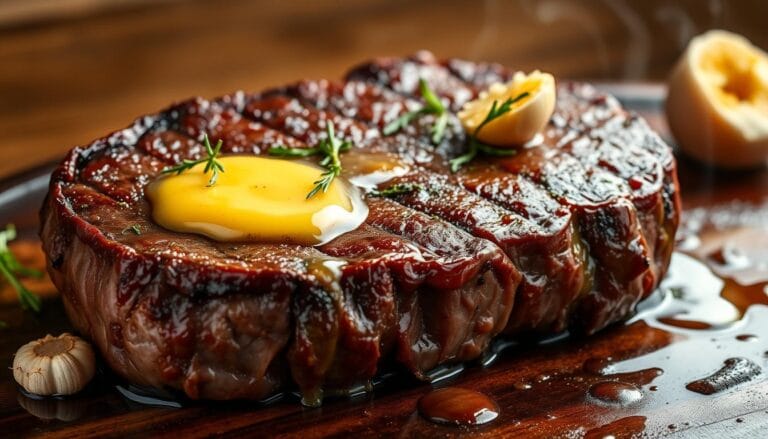Classic French Steak Tartar in 3 Easy Steps
Imagine enjoying a gourmet appetizer that captures the essence of fine dining. Each bite of steak tartar is a rich experience. This classic French dish needs precision and care to be truly exceptional.
A well-made steak tartar is a mix of flavors and textures. The tender beef, seasoned just right, is the star. It’s a popular dish that balances bold flavors with a delicate touch. This makes each bite a perfect blend of taste and sophistication.
Introduction to Steak Tartar
this Steak is a true delicacy in fine dining, with a rich history and cultural significance. Mastering this dish can impress your guests and create lasting memories. Whether you’re a seasoned chef or a home cook, making perfect steak is achievable. The effort is well worth it.
Key Takeaways of steak tartar
- Steak tartar is a classic French dish made from finely minced beef, seasoned with spices, and served raw.
- A gourmet appetizer that requires careful preparation to ensure food safety and quality.
- High-quality ingredients and techniques are essential to create an exceptional dining experience.
- A traditional recipe provides a foundation for innovation and experimentation.
- Steak tartar is a popular dish in fine dining establishments, offering a unique opportunity to impress guests.
- Mastering the art of steak tartar preparation can elevate your culinary skills and create unforgettable memories.
- With practice and patience, anyone can become a steak tartar expert and enjoy this beloved dish in the comfort of their own home.
The Rich History Behind Steak Tartar
This Steak is a raw beef dish from classic french cuisine. It has a long and interesting history. It dates back to the Middle Ages, influenced by the Mongols who ate raw meat on long journeys.
This steak became a favorite in classic french cuisine over time. It was often served as an appetizer. Today, it’s loved worldwide, with chefs adding their own twist to the traditional recipe.
Origins of steak tartar in French Cuisine
In classic french cuisine, the steak is seasoned with capers, onions, and egg yolks. It’s made with top-quality raw beef, finely chopped and seasoned.
Evolution of steak tartar through the Centuries
As classic french cuisine grew, so did steak tartar. It was shaped by different cultures, making it a flavorful raw beef dish we enjoy today.
Modern Interpretations of steak tartar
This dish is still a hit in fine dining. Modern chefs add their own touches to the traditional recipe. It’s served with unique condiments and paired with various wines and drinks.
Essential Ingredients for Authentic Steak Tartar
To make a real tartar, you need top-notch ingredients. This includes finely minced beef, the base of the dish. The beef must be seasoned with spices to boost its taste. It’s also key to follow food safety rules to avoid contamination.
The Steak is all about being served raw. So, the quality of your ingredients matters a lot. To get the flavors just right, pick the right seasonings and handle them carefully. Here are some tips for picking the best ingredients:
- Choose a trusted supplier for your finely minced beef to get it fresh and of high quality.
- Pick spices that go well with the beef, like paprika, garlic, and onion.
- Keep the ingredients safe to avoid cross-contamination and foodborne illness.
By sticking to these tips and using the best ingredients, like finely minced beef seasoned with spices, you can make a real steak . It will be tasty and safe to eat. Always handle the ingredients safely and serve the dish raw to keep its unique flavor and texture.
Selecting the Perfect Cut of Beef
Creating a raw meat delicacy like steak tartar requires top-notch beef. A gourmet appetizer like this needs the best ingredients for a safe and tasty meal. Knowing how to pick the best beef is key.
Choosing the right cut of beef involves looking at several things. These include the breed, what the beef ate, and how long it was aged. Grass-fed and dry-aged beef are favorites for steak tartar. They are tender and have a deep flavor.
Prime Beef Selection Guidelines
- Choose beef with good marbling for better flavor and texture.
- Go for beef from trusted sources like local farms or top butchers.
- Consider where the beef comes from. Some places raise better cattle.
Best Cuts for steak Tartar
The best cuts for this steak are tenderloin, strip loin, and ribeye. These cuts are tender and full of flavor. They’re perfect for a raw meat dish like steak tartar.
Quality Indicators to Look For
| Indicator | Description |
|---|---|
| Color | A rich, red color means high-quality beef. |
| Texture | Tender and fine-grained beef is best for steak tartar. |
| Aroma | A nice, beefy smell shows the beef is fresh and good. |
By following these tips and picking the right beef, you’ll make an amazing steak tartar. This gourmet appetizer will wow even the pickiest eaters.
Critical Food Safety Guidelines for steak tartar
When you’re working with raw beef for steak tartar, it’s key to stick to food safety rules. This helps avoid contamination and keeps you safe from foodborne illness. Make sure your workspace is clean, store ingredients right, and handle the meat carefully.
To keep things safe, follow these handling guidelines. Wash your hands well before and after touching raw beef. Keep raw meat away from foods you can eat right away. And, make sure to cook or freeze the meat to the right temperature.
- Keep raw beef at 40°F (4°C) or colder.
- Stop cross-contamination by keeping raw beef separate from other foods.
- Cook or freeze raw beef to at least 145°F (63°C) for food safety.
By sticking to these handling guidelines and being careful, you can have a tasty and safe steak . Remember, food safety is very important when you’re working with raw beef. The right handling and storage are key to avoiding foodborne illness.
Classic Steak Tartar Preparation Techniques
To make a traditional tartar, you need top-notch ingredients and classic French cooking methods. This raw beef dish needs careful handling to keep it safe and tasty.
Preparing this steak involves a few important steps. These include:
- Hand-chopping vs. machine grinding: Hand-chopping gives a more textured, authentic taste. Machine grinding makes it finer and more uniform.
- Temperature control: Keeping ingredients cold is key to avoid bacterial growth and foodborne illness.
- Seasoning methods: Using quality seasonings like fresh black pepper and finely chopped shallots can enhance the flavor.
By sticking to these traditional methods and using classic French techniques, you can make a delicious, authentic dish. It’s sure to wow your guests.
| Preparation Method | Advantages | Disadvantages |
|---|---|---|
| Hand-chopping | Textured and authentic experience | Time-consuming and labor-intensive |
| Machine grinding | Finer and more uniform texture | Can result in over-processing and loss of texture |
Traditional and Modern Accompaniments of steak tartar
Serving the tartar with the right accompaniments can make it a special dish. Classic French pairings like toasted bread, capers, and a quail egg are often used. These add texture and flavor, balancing the richness of the steak.
Today, chefs are trying new things . They use fresh herbs, citrus, and seasonal ingredients for a unique twist. For example, a squeeze of lemon or some microgreens can brighten the flavor. Popular additions include:
- Grilled or toasted bread for a crunchy texture
- Pickled vegetables, such as onions or carrots, for a tangy flavor
- Fresh herbs, like parsley or chives, for a pop of color and flavor
These extras not only taste great but also make the dish look amazing. Whether you like traditional or modern pairings, the goal is to mix flavors and textures well. This makes the steak tartar unforgettable.
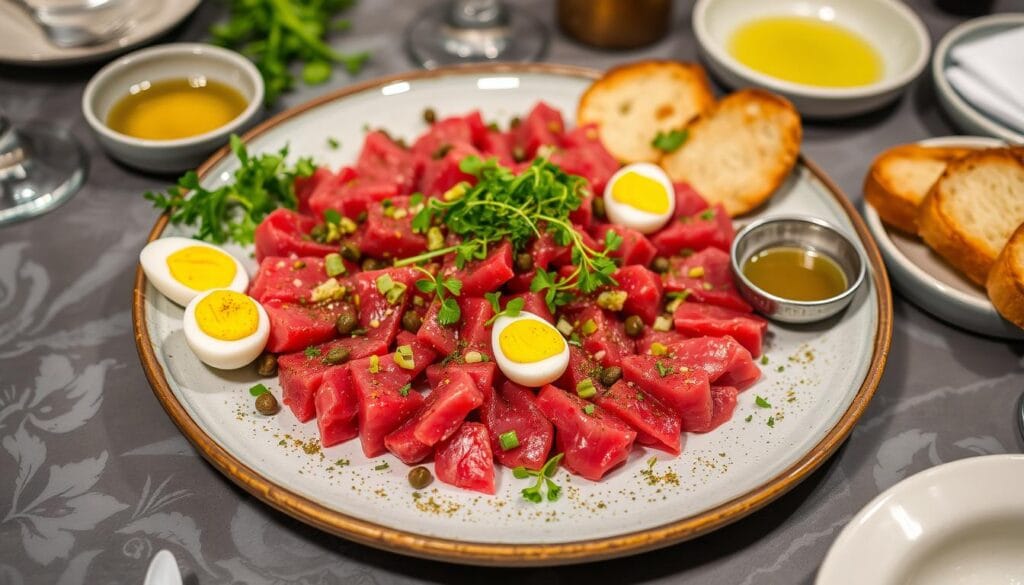
Trying different accompaniments can make your steak stand out. It shows off your cooking skills and creativity. So, don’t be shy to experiment and find your favorite recipe.
| Accompaniment | Flavor Profile | Texture |
|---|---|---|
| Toasted bread | Crunchy, slightly sweet | Crispy |
| Pickled vegetables | Tangy, sour | Crispy |
| Fresh herbs | Bright, refreshing | Delicate |
Wine and Beverage Pairing Guide
Finding the right wine or beverage to pair with the steak is key. A good wine pairing can make the flavors of the tartar pop. On the other hand, a beverage pairing can add a refreshing twist. For a gourmet appetizer like steak tartar, a dry and crisp white wine is often a great pick.
Some top picks for wine pairing with steak tartar include:
- Champagne: adds a celebratory touch to the dish
- Pinot Noir: a light-bodied red wine that complements the flavors of the steak
- Riesling: a white wine with high acidity that cuts through the richness of the dish
But wine isn’t the only game in town. Craft beer or cocktails can also pair well. A dry martini or a glass of champagne can be perfect for starting a meal with this steak as a gourmet appetizer. The goal is to balance the flavors of the dish and the drink, and to have fun trying new things.
The right choice between wine pairing or beverage pairing depends on your taste and the meal’s vibe. With a bit of experimentation and creativity, you can find the perfect match. This will make your steak experience unforgettable and truly special.
Professional Chef Tips for Perfect Steak Tartar
To make a top-notch tartar, focus on the details, just like a pro chef does. This dish needs a mix of great flavors and textures. Getting it right means knowing about texture, flavor, and how to present it.
Choosing the best ingredients is key, a pro chef will tell you. Pick the finest beef and handle it carefully to keep it clean. This way, you’ll make a dish that looks amazing and tastes great, perfect for any event.
Texture Perfection in steak tartar
Texture is very important in this steak tartar. A pro aims for a mix of tender beef and crunchy bits. This is done by chopping the beef finely and adding things like capers and onions.
Flavor Balancing in steak tartar
Getting the flavors right is also crucial. A pro uses seasonings and condiments to bring out the beef’s taste. They might add lemon juice, paprika, or crème fraîche.
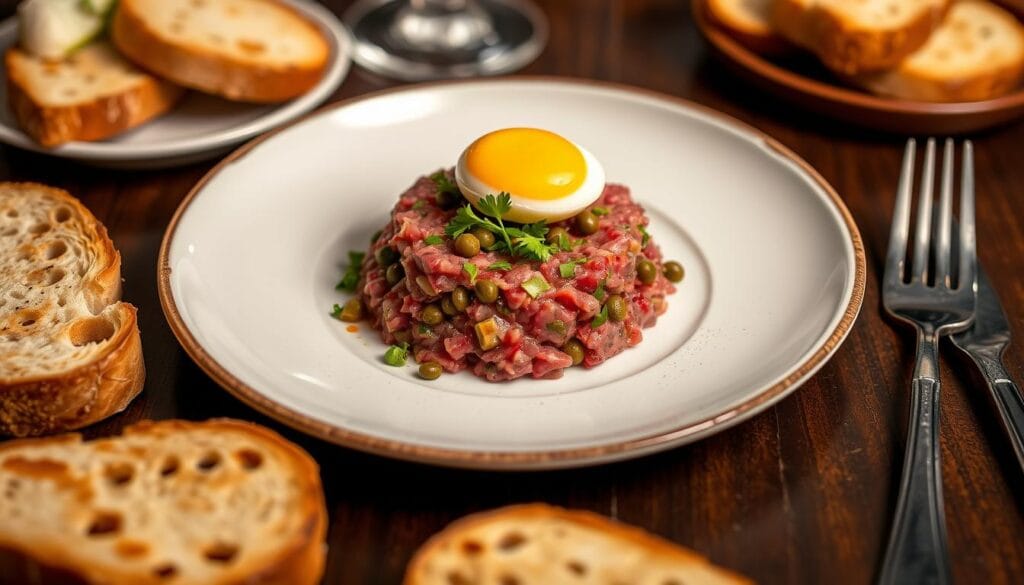
Plating Techniques of steak tartar
How you present the dish is just as important. A pro will make it look neat and elegant. They might use fresh herbs or flowers to make it look good.
By using these tips, you can make a tartar that will wow your guests. It’s perfect for appetizers or a light meal, with its rich tastes and soft textures.
Conclusion: Mastering the Art of Steak Tartar
This dish is a true culinary masterpiece. It’s a gourmet appetizer that requires quality ingredients and skill. A good traditional recipe needs attention to detail and a commitment to tradition.
To make great steak tartar, start with the best beef. Choose cuts that are tender and fresh. Hand-chopping the meat lets you control the texture and flavor balance in every bite.
Try it with classic French sides or add a modern twist. The goal is to create a dish that excites your senses. Whether you’re a pro chef or a home cook, learning to make steak tartar is rewarding. It adds elegance and flavor to your meals, making every bite special.

